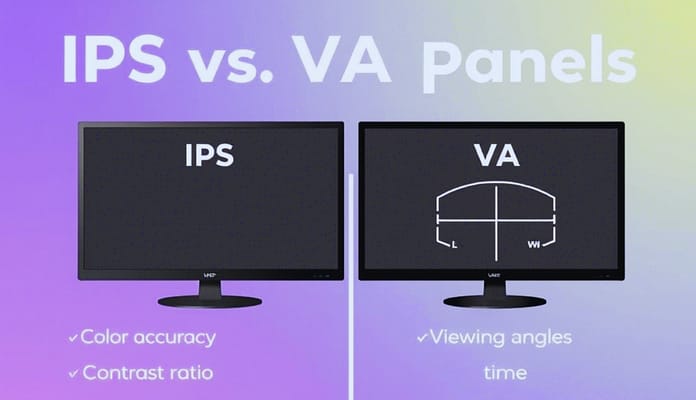
If you’re shopping for a new monitor, you’ve likely stumbled into the confusing world of display technologies. Terms like “IPS” and “VA” get thrown around, but what do they actually mean for someone who just wants a good screen for everyday use?
Whether you’re binge-watching Netflix, working from home, or casually gaming, the type of panel your monitor uses matters more than you think.
In this guide, we’ll break down IPS vs VA panels in plain language, focusing on what casual users (like you!) need to know. No jargon, no tech overload—just practical advice to help you decide which panel type suits your needs. Let’s dive in!
Table Of Content
What Are IPS and VA Panels?
First, let’s decode the basics.
IPS (In-Plane Switching) Panels
Developed by Hitachi in the 1990s, IPS panels are known for their superior color accuracy and wide viewing angles. They’re the go-to choice for graphic designers, photographers, and anyone who needs precise color reproduction.
Key Features:
- Colors stay consistent even when viewed from the side.
- Ideal for tasks requiring color precision (e.g., photo editing).
- Generally more expensive than VA panels.
VA (Vertical Alignment) Panels
VA panels, on the other hand, prioritize contrast ratios and deeper blacks. They’re a middle ground between IPS and TN (Twisted Nematic) panels, offering better color reproduction than TN but falling short of IPS in viewing angles.
Key Features:
- Deeper blacks and higher contrast (great for movies and dark rooms).
- Slightly slower response times compared to IPS (relevant for gaming).
- More affordable than IPS in many cases.
IPS vs VA for Everyday Use
Let’s compare how these panels perform in real-world scenarios for casual users.
1. Watching Movies and Streaming
- IPS Panels: Colors look vibrant and natural, but blacks can appear slightly gray in dark scenes. If you’re watching in a bright room, IPS handles glare well.
- VA Panels: The clear winner here! VA’s high contrast ratio (3000:1 vs IPS’s 1000:1) makes dark scenes in movies like Stranger Things or The Batman look richer and more immersive.
Verdict: VA panels for movie buffs who love cinematic visuals.
2. Office Work and Web Browsing
- IPS Panels: Wide viewing angles mean you can glance at your screen from the side without colors shifting—perfect for sharing spreadsheets or collaborating.
- VA Panels: Text might look slightly less sharp due to slower pixel transitions. However, VA’s high contrast can reduce eye strain in dimly lit home offices.
Verdict: IPS panels if you prioritize screen clarity and multitasking.
3. Casual Gaming
- IPS Panels: Faster response times (1-5ms) reduce motion blur in games like Fortnite or Minecraft. Colors pop, but darker game scenes may lack depth.
- VA Panels: Higher contrast makes games like Hogwarts Legacy or Resident Evil look moodier, but slower response times (4-8ms) can cause ghosting in fast-paced games.
Verdict: IPS panels for competitive gamers; VA panels for story-driven, atmospheric games.
4. Content Creation (Photos, Videos)
- IPS Panels: The gold standard for color accuracy. If you edit Instagram photos or YouTube videos, IPS ensures your greens look green and your reds look red.
- VA Panels: While decent, VA panels can struggle with color consistency at different angles. Not ideal for pro work but fine for casual edits.
Verdict: IPS panels for creators; VA panels for hobbyists.
Pros and Cons at a Glance
IPS Panels
| Pros | Cons |
|---|---|
| Stunning color accuracy | Higher price tag |
| Wide viewing angles | Mediocre contrast ratios |
| Fast response times | Glow effect in dark rooms |
VA Panels
| Pros | Cons |
|---|---|
| Deep blacks & high contrast | Narrow viewing angles |
| Affordable options | Slower response times |
| Great for dark rooms | Color shifts at angles |
Which Panel Should YOU Choose?
Ask yourself these questions:
- “Do I watch a lot of movies or play story games?” → VA Panels
- “Do I need accurate colors for hobbies or work?” → IPS Panels
- “Am I on a tight budget?” → VA Panels (more affordable options)
- “Do I hate glare in bright rooms?” → IPS Panels (better anti-glare coatings)
Still unsure? Here’s a quick cheat sheet:
- IPS: Best for color-sensitive tasks, collaboration, and bright rooms.
- VA: Best for movie nights, budget buyers, and dark rooms.
Common Myths Debunked
Myth 1: “IPS is always better than VA.”
Not true! VA panels excel in contrast and affordability. For casual users who don’t need pro-level color accuracy, VA is often the smarter buy.
Myth 2: “VA panels are bad for gaming.”
While IPS is faster, modern VA panels with adaptive sync (FreeSync/G-Sync) work well for casual gaming. Just avoid VA if you’re into ultra-competitive esports.
Myth 3: “All IPS panels have terrible contrast.”
Newer IPS models like Nano IPS or IPS Black have improved contrast ratios, closing the gap with VA.
Top Monitor Recommendations
Here are budget-friendly picks for casual users:
Best IPS Monitors Under $ 250
- LG 24QP500-B – 24″ QHD for sharp text and colors.
- Dell S2421HS – Sleek design with great viewing angles.
Best VA Monitors Under $ 250
- Samsung Odyssey G32A – 165Hz refresh rate for smooth gaming.
- AOC C24G1 – Curved screen for immersive movies.
FAQs About IPS vs VA Panels
Q: Can VA panels handle bright rooms?
A: Yes, but IPS panels generally handle glare better due to anti-reflective coatings.
Q: Do IPS panels cause more eye strain?
A: Not necessarily. Both panel types offer flicker-free and low-blue-light options.
Q: Which lasts longer: IPS or VA?
A: Both have similar lifespans (30,000+ hours). Durability depends more on the brand.
Conclusion
Choosing between IPS and VA panels boils down to your priorities. If you want vibrant colors and wide angles for work or creative projects, IPS is worth the investment. If you’re after cinematic contrast and want to save money, VA is your friend.
Remember, there’s no “perfect” panel—just the one that fits your lifestyle. Now that you’re armed with knowledge, go forth and find the monitor that makes your Netflix nights, Zoom calls, or Minecraft marathons shine!




















